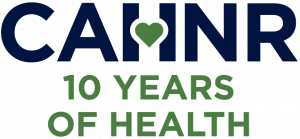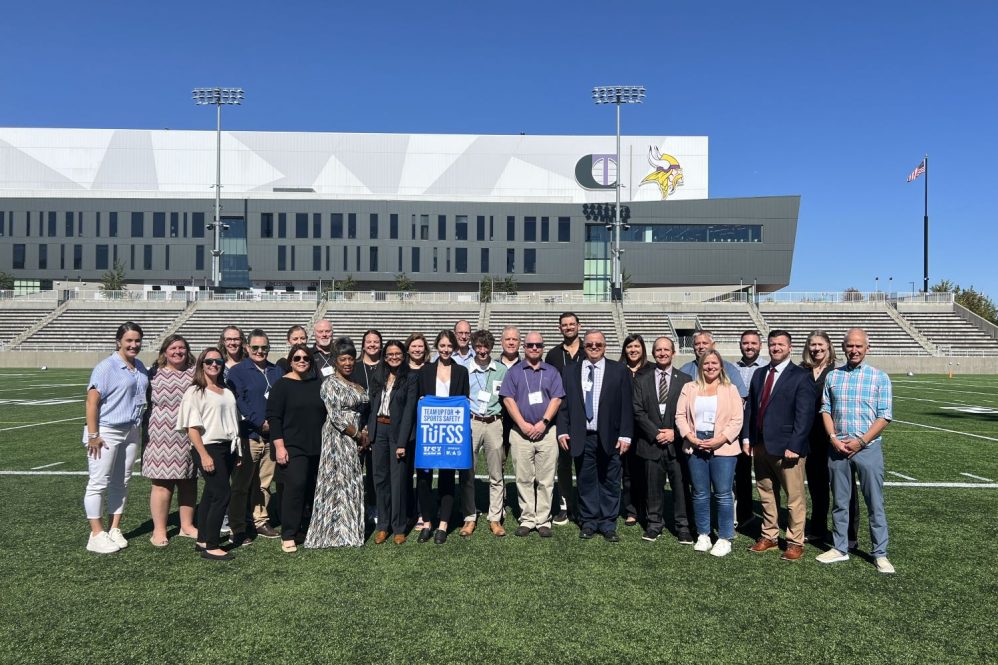The Korey Stringer Institute (KSI), a national sports safety research and advocacy organization located within UConn’s College of Agriculture, Health and Natural Resources (CAHNR), recently convened dozens of Minnesota’s foremost experts in medicine and sports as part of its Team Up for Sports Safety (TUFSS) initiative. The goal of the meeting was to develop a policy roadmap that advances best medical practices to reduce sport-related deaths. The group was hosted at Vikings Lake and assembled representatives from the Minnesota High School League’s sports medicine advisory committee, the Minnesota Athletic Trainers’ Association, sports medicine physicians, legislators, and others to discuss policies to improve high school sport safety in Minnesota.
 “We know that implementation of these important health and safety policies is the first step toward reducing sport-related fatalities,” says KSI CEO and Board of Trustees Distinguished Professor at the University of Connecticut, Douglas Casa, ATC, FNAK, FACSM, FNATA. “We are excited that Minnesota is taking action to continue to improve its policies so they are in line with best practices for preventing sudden death in sport.”
“We know that implementation of these important health and safety policies is the first step toward reducing sport-related fatalities,” says KSI CEO and Board of Trustees Distinguished Professor at the University of Connecticut, Douglas Casa, ATC, FNAK, FACSM, FNATA. “We are excited that Minnesota is taking action to continue to improve its policies so they are in line with best practices for preventing sudden death in sport.”
Since launching its “Team Up for Sports Safety” (TUFSS) campaign in 2017, Minnesota is the 46th state that KSI has visited to work with state leaders to propel health and safety policy adoption forward.
The location also adds extra significance, since the institute is named in honor of Korey Stringer, pro-bowl offensive tackle for the Minnesota Vikings who died from an exertional heat stroke during training camp in August, 2001. Following Korey’s death, his widow Kelci Stringer, his agent Jimmy Gould, and expert witness in his case Dr. Douglas Casa worked directly with the NFL to create a non-profit organization dedicated to preventing sudden death in sport which later became the Korey Stringer Institute in 2010.
Since then, the Korey Stringer Institute has developed and disseminated practical strategies to prevent sudden death in sport, military, and laborers, promote health and safety best practices in the physically active, and optimize performance.
“The power of the TUFSS meeting is in collaboration,” says KSI Medical and Science Advisory Board member and emergency medicine physician at the Mayo Clinic, Neha Raukar MD, MS, FACEP, CAQ-SM. “By having experts, decision makers, and community leaders in one room, we can identify the most effective ways to adopt and implement safety measures that fit the specific needs of Minnesota’s athletes.”
Research has shown that nearly 90 percent of all sudden death in sports is caused by four conditions: sudden cardiac arrest, traumatic head injury, exertional heat stroke, and sudden collapse association with sickle cell trait. It has also been shown that adopting evidence-based safety measures significantly reduces these risks and can save lives.
Minnesota’s TUFSS meeting was focused on advancing policies in four key topic areas: pre-participation physical exams, CPR/AED training for all coaches, exertional heat stroke treatment, and emergency action planning. Policies discussed during the meeting are proven to support athlete safety. For example, venue specific emergency action plans, in combination with early access to CPR and AEDs, have been shown to increase the rates of sudden cardiac survival by as much as 90%. Additionally, cold water immersion has saved 100% of heat stroke victims when utilized within 10 minutes of the heat stroke.
“The Minnesota Athletic Trainers’ Association is very excited to convene with stakeholders in the state of Minnesota on the topic of sports safety,” says Minnesota Athletic Trainers’ Association president, Josh Pinkney, MS, LAT, ATC. “The TUFSS meeting provides an incredible platform for a diverse community to come together, review best practices, and positively influence the landscape of sports safety in our wonderful state.”
The meeting sought to produce best practice policy language for each of the four topic areas which will be taken forward by the MSHSL Sports Medicine Advisory Committee for consideration by the MSHSL and possible legislative pathways will be discussed.
“Hosting an event like this is so important for the state of Minnesota,” says Minnesota Athletic Trainers’ Association state representative, Troy Hoehn, LAT, ATC, CSCS, ITAT. “Having policies in place are paramount to ensure that everyone can come together to truly protect our young student-athletes. We all know that it isn’t a matter of if, but when. When these injuries happen, we need to provide the best care to lead to the best possible outcome. Everyone playing in a sport deserves to have fun and every student-athlete and their parents and caregivers need to know that their health and safety are being taken seriously.”
This work relates to CAHNR’s Strategic Vision area focused on Enhancing Health and Well-Being Locally, Nationally, and Globally.
Follow UConn CAHNR on social media



